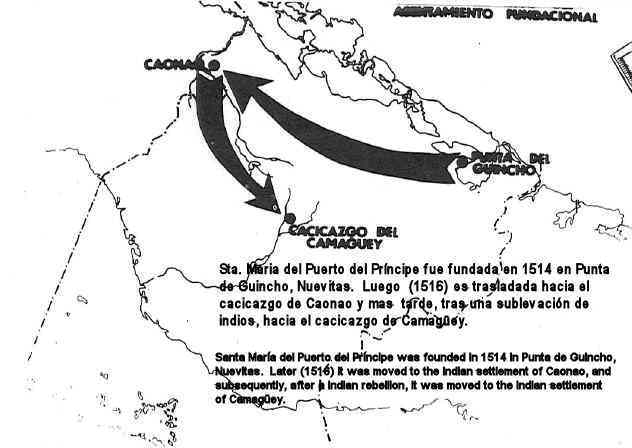|
Summary of the City of Camagüey’s Founding and Growth from the 16th - 20th Centuries |
||
English Menu
|
Santa María del Puerto del Príncipe, one of the first seven settlements established in Cuba, was founded in 1514 in Punta de Guincho, Nuevitas, on the north coast. In 1516 the settlement is moved to the inland Indian settlement of Caonao. The main reason for this move was the difficulty in distributing water to the settlers and the abundance of mosquitoes. After a series of rebellions by the Indians, the settlement was moved once more, this time to the settlement of Camagüey, between the rivers Tínima and Hatibonico, its present location. (See graphic rendering below). As is apparent in the plans included here, the city evolved in an irregular manner, instead of the checker-board style encouraged by the Spanish crown. Some streets are extremely narrow, interrupted by unexpected plazas. Many urban blocks have triangular shapes among twisted roads. It is worth mentioning that a large city such as Santiago de Cuba, with the irregular topography of a mountain region, follows a regular urban plan. Camagüey, built on completely flat terrain, is the most irregular of all Cuban cities. |
Menu español |
|
|
||

In 1528 the city is established. A large cross brought from Caonao is planted at the straight line that joins the two rivers. Today, this spot coincides with the intersection of General Gómez and Goyo Benítez Streets.
In 1599 the convent of San Francisco is founded, followed (1602) by the convent of La Merced, in the same place it occupies today (reconstructed in 1748). Not long after, and in order to establish communications with Santiago de Cuba, Trinidad, and Bayamo, several ports are created, as well as roads to them in Vertientes, Nuevitas, and El Jigüey.
In 1616 Puerto Príncipe is assaulted and burned by slaves that revolted in the center of the island. Remaining are the original large cross, the bell from City Hall, and the church of La Merced.
At the
beginning of 1617 the city is re-erected. The center
coincides with Plaza Maceo, where the original large cross
was planted once more.
In 1620 the clay industry begins with the manufacturing of bricks, roof tiles and large clay pots (tinajones), all of which forms the bases of typical Puerto Príncipe buildings. Construction of the main road (Camino Real) begins. The road would unite the city with Havana and Santiago de Cuba.
In 1668 English pirate Henry Morgan ransacks the city and burns it down. Again, the church of La Merced survives the attack. The city is re-constructed and later attacked and ransacked by the pirate Francoise Granmont (1679).
In 1692 a fierce hurricane caused the destruction Puerto Príncipe, and in 1698 an epidemic of unknown origin diminished the population considerably. Later a phenomenon named “snake disease” about which no details are available, brought more suffering to the city.
Between 1701 and 1799 an economic boom brought about the construction of twelve important edifications. Among them were the San Juan de Dios Hospital and Convent, the bridge of La Caridad (initially made of wood and stone), and the bridge of San Lázaro.
During this period, the Plaza Mayor (today Agramonte Park) is the social focus of Puerto Príncipe. Horse races take place there, as well as public festivals and executions. Religious life was fundamental at that time. Festivities called “Sanjuanes” were public celebrations that had their origin in the sale of cattle during the month of June.
The fair of La Caridad offered carriage rides. Later on, exhibits were organized for the fair and the park known as Casino Campestre was constructed. Recreational activities for the poor included the decoration of altars and festivities related to African traditions and religions.
Between 1805 and 1867 fifteen important edifications are erected. Among them: The Cemetery, the Orphanage, The Campo de Marte (later Casino Campestre), Principal Theater, Popular Society, Bullfighting Rink, and the Jail. Later on, fifteen fortresses are constructed for the defense of the city during the war of independence.
Between 1900 and 1930 new neighborhoods are incorporated and the burrough of La Vigía is consolidated.
Present-day Camagüey
|
||
.jpg)
.jpg)
.jpg)

.jpg)
.jpg)
.jpg)
.jpg)